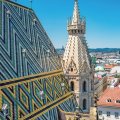SAINT ETIENNE'S CATHEDRAL (STEPHANSDOM)
The church where Mozart married Constance Weber symbolizes and magnifies St. Stephen's Square.
It symbolizes Vienna and magnifies St. Stephen's Square. The Viennese nickname it "Steff'l", and everyone, believers and non-believers alike, has a great fondness for it. It was in this church that Mozart married Constance Weber in 1782.
The origins. The church was probably built on the site of an ancient pagan sanctuary dedicated to the cult of fertility, dating from Roman times. This 12th-century Romanesque basilica has preserved its central portal, the Porte des Géants. The two Pagan towers that flank it are adorned with statuettes representing demons and pious figures. The Gothic architecture of the Stephansdom, begun in 1359, is the work of Rudolf IV of Habsburg, known as the "Builder".
The decor. Outside, gargoyles ward off evil spirits. Inside, the great nave with its three naves and arched vaults rises to a height of around 40 m. Gothic details stand side by side with Baroque exuberance following the victory over the Muslim Ottomans, largely dedicated to the Virgin Mary, as Vienna's victory over the Turks took place on her feast day in 1683.
At 136 m,the Guard Tower is the third-highest bell tower in Central Europe, after Ulm and Cologne. While the Pummerin Tower is equipped with an elevator, the 300-odd steps of the south tower can only be climbed on foot!
The Pummerin Tower is home to the Pummerin Bumblebee, Austria's largest, which rings in the New Year. Shortly before midnight, the Stephansplatz is packed with people. The original bell was cast from the metal of Turkish cannons seized in 1683. When the cathedral burned down during the Second World War, the Pummerin broke off and crashed to the ground. The current bell is a copy, donated by the province of Upper Austria in 1952.
The catacombs. Here you'll find the tombs of bishops and several emperors. Guided tours only, no reservation required, but in English. The nave on the right houses the red marble tomb of Emperor Frederick III, who was granted independent bishopric status for Vienna by the Vatican. In 1732, up to 150 masses were held here every day! The pulpit, executed around 1515 by Anton Pilgram, is a must-see. The author himself is depicted in a signature self-portrait (the famous Fenstergucker) at a window, a common practice at the time. To the right of the entrance is the ducal crypt, which houses a magnificently carved wooden altarpiece (1507).
Did you know? This review was written by our professional authors.
Book the Best Activities with Get Your Guide
Members' reviews on SAINT ETIENNE'S CATHEDRAL (STEPHANSDOM)
The ratings and reviews below reflect the subjective opinions of members and not the opinion of The Little Witty.
Find unique Stay Offers with our Partners








L extérieur et l intérieur sont magnifiques.